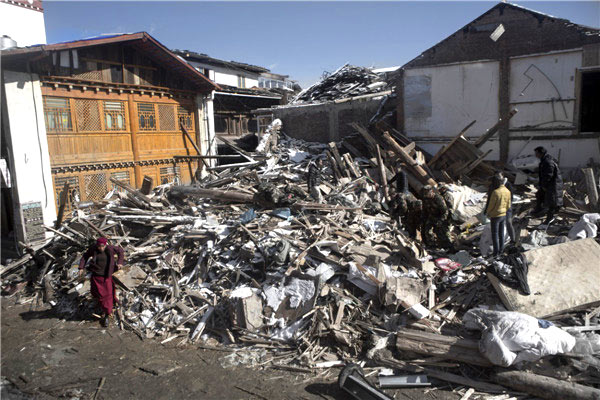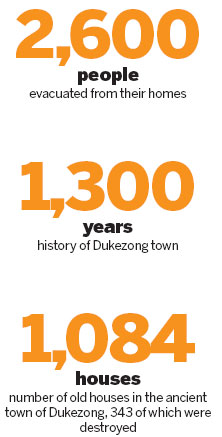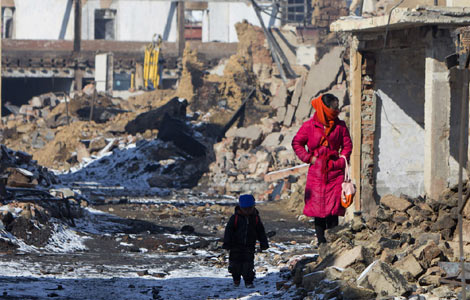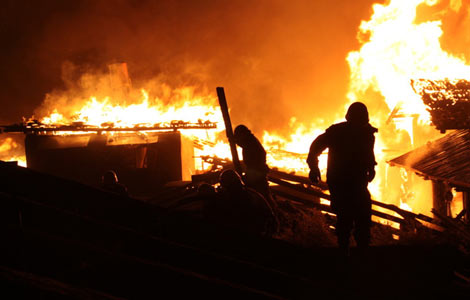Shangri-la assets lost forever after town blaze
Updated: 2014-01-14 09:22
(China Daily)
|
|||||||||||
 |
|
The ruins of old houses scattered around the ancient town of Dukezong in Yunnan province after the blaze on Saturday. Qu Mingfei / for China Daily |
"Our memories of a simple, relaxed life are gone forever. In traditional Tibetan architecture, the roof isn't nailed onto the supports, so if a fire breaks out, it can be removed quickly and easily and the fire-affected section can be cut out. But the new buildings don't follow that rule. In one sense that accelerated the spread of the fire," said Li.
The town was designed to minimize the danger posed by fire, according to Li. The original architects ensured that there were wide spaces between the buildings and they also incorporated a firebreak that kept stockpiles of fertilizer and firewood isolated from the main buildings in the event of fire.
However, recent construction work has reduced the size of the "safe area" and the crowded buildings and narrow streets have become hazardous, he said.
Cao Baoming, vice-president of the Chinese Folk Literature and Art Society was also critical of the recent changes. "The over-exploitation of business potential isn't just a problem in Dukezong, but also in many other ancient towns and villages, such as Dali and Lijiang. Because the traditional buildings are made of wood, this fire has rung alarm bells about the safety of ancient architecture nationwide," he said.
Many experts are of the opinion that having residents living and working inside the old settlements is the best way to keep towns and villages alive in the modern age, but it should all be contained within a certain range, because the cultural heritage is unique and can't be replicated. Once destroyed, it is lost irretrievably, he said.
Time to rebuild
Dukezong resident Song Yunfeng was devastated to see the town reduced to rubble. "Before the fire, if the weather permitted, people came out to dance in the square every evening. I hope the town can be rebuilt soon and we can resume a normal life," she said.
Huo Yaozhong, a professor at the Academy of Fine Arts at Shanxi University who has researched the protection of ancient architecture for many years, said the search for profits was unbalanced. He noted that some local entrepreneurs have altered original structures to meet the demands of their businesses, destroying the original facades in the process.
The problem of local governments attaching great importance to the exploitation of ancient architecture and cultures, but paying scant attention to their protection is a nationwide problem, said Huo.
Opening ancient towns to tourism and providing visitors with the opportunity to learn about the culture and charm of traditional settlements is a good way of protecting the heritage, but good planning is essential, he added.
Li said rebuilding Dukezong will present the local government and architectural experts with huge challenges. "Although ancient architecture should preferably be rebuilt using materials as close to the originals as possible, I would prefer to see modern fireproof materials used in Dukezong. As long as the town is a hotspot for tourists, fires and other safety concerns will always exist. Fireproof materials would be the wisest choice," he said.
Cao stressed that the repair work should be carefully planned. "I don't think the rebuilding process should start immediately; on the contrary, a comprehensive plan should be formulated before any work begins. It should be based on cultural research, local history and the regional environment."
Contact the writers at hena@chinadaily.com.cn, yangyangs@chinadaily.com.cn and huyongqi@chinadaily.com.cn
Slides: Ancient town catches fire in China's Shangri-la
Related Stories
Shangri-la assets lost forever after town blaze 2014-01-14 07:27
Probe finds electrical fault caused Shangri-la fire 2014-01-13 21:34
Shangri-la old town burns 2014-01-12 08:36
Fire in China's Shangri-la put out 2014-01-11 23:12
Ancient town in Shangri-la devastated by fire 2014-01-11 20:39
Huge loss estimated in Shangri-la fire in SW China 2014-01-11 19:21
Today's Top News
Man says loss of face pushed him to kill six
Liquor maker jettisons public autos at auction
Less school is better for finding love: official
Newspapers must change or die
China pouring billions into London real estate
Beijing, Sofia vow new initiatives
Bangkok unrest hurts major projects
Army built 'with peace in mind'
Hot Topics
Lunar probe , China growth forecasts, Emission rules get tougher, China seen through 'colored lens', International board,
Editor's Picks

|

|

|

|

|

|






